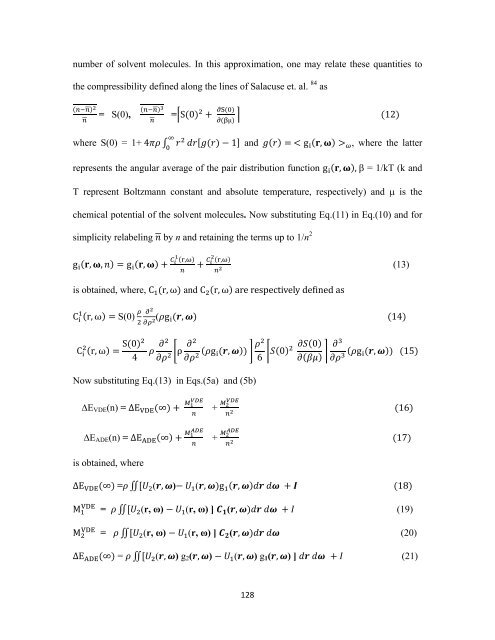CHEM01200604005 A. K. Pathak - Homi Bhabha National Institute
CHEM01200604005 A. K. Pathak - Homi Bhabha National Institute
CHEM01200604005 A. K. Pathak - Homi Bhabha National Institute
You also want an ePaper? Increase the reach of your titles
YUMPU automatically turns print PDFs into web optimized ePapers that Google loves.
number of solvent molecules. In this approximation, one may relate these quantities to<br />
the compressibility defined along the lines of Salacuse et. al. 84 as<br />
<br />
<br />
= S(0),<br />
<br />
<br />
=S0 S<br />
µ <br />
12<br />
where S(0) = 1+ 4 <br />
<br />
<br />
<br />
1 and g , , where the latter<br />
represents the angular average of the pair distribution function g , , β = 1/kT (k and<br />
T represent Boltzmann constant and absolute temperature, respectively) and μ is the<br />
chemical potential of the solvent molecules. Now substituting Eq.(11) in Eq.(10) and for<br />
simplicity relabeling by n and retaining the terms up to 1/n 2<br />
g , , g , ,<br />
<br />
,<br />
(13)<br />
is obtained, where, C r, ω and C r, ω are respectively defined as<br />
<br />
C r, ω S(0) (g , <br />
14<br />
C r, ω S0<br />
4<br />
<br />
ρ<br />
g , 0<br />
0<br />
6 <br />
g , 15<br />
Now substituting Eq.(13) in Eqs.(5a) and (5b)<br />
∆E VDE (n) = ∆E DE ∞ <br />
∆E ADE (n) = ∆E DE ∞ <br />
<br />
<br />
+ <br />
16<br />
+ <br />
17<br />
is obtained, where<br />
∆E DE ∞ = (, ) (, g , <br />
18<br />
M <br />
DE<br />
= (r, ω) (r, ω) ] (, (19)<br />
M <br />
DE<br />
= (r, ω) (r, ω) ] (, (20)<br />
∆E DE ∞ = (, ) g 2 (, ) (, ) g 1 (, ) ] (21)<br />
128
















